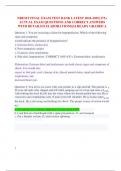NREMT FINAL EXAM TEST BANK LATEST 2024-2025| 275+
ACTUAL EXAM QUESTIONS AND CORRECT ANSWERS
WITH DETAILED ELABORATIONS|ALREADY GRADED A
Question 1: You are assessing a client for hypoperfusion. Which of the following
signs and symptoms
would indicate the presence of hypoperfusion?
a. Extreme thirst, restlessness
b. Poor mentation, stridor
c. Cyanosis, slow respirations
d. Pale skin, hypertension - CORRECT ANS ✔✔ a. Extreme thirst, restlessness
Elaboration: Extreme thirst and restlessness are both classic signs and symptoms of
shock. You would also
expect to find pale, cool, clammy skin, altered mental status, rapid and shallow
respirations, and
increased heart rate.
Question 2: You arrive on scene with your partner to a slip and fall. The patient is a
49 year old male who slipped and fell while jumping out of a boat and onto a d ock.
After hitting the dock he fell into the water where his friends pulled him out. He is
conscious and complaining only of pain in his left shoulder. He is laying supin e on
the dock. He is shivering and holding his elbow. The proper course of action would
be?
a. Cut off the wet clothing, high flow Ó, and check CMS
b. Load him on a backboard with c spine precautions, Ó, and transport
c. Put a blanket on him, Ó, and traction splinting
1
,d. Ó, traction splinting, and transport - CORRECT ANS ✔✔ a. Cut off the wet
clothing, highflow Ó, and check CMS
Elaboration: Getting the wet clothes off him to help prevent shock, along with
High flow Ó, and checking the ciruclation, motor function, and sensation of the
affected
limb would be the best choice. The other answers never checked CMS which is
very necessary.
Question 3: Where is the ulna located in the body? a.
The thumb side of the arm
b. The big toe side of the leg
c. The little toe side of the leg
d. The little finger side of the arm - ANSWER- d. The little finger side of the arm
Elaboration: The ulna is the outside bone of the arm in line with the little finger.
Question 4: What is the best definition of a fistula used in hemodialysis?
a. An external shunt
b. An internal connection between a graft and a shunt
c. A surgically created connection between a venule and an artery.
d. An internal shunt - CORRECT ANS ✔✔ d. An internal shunt
Elaboration: The best definition of a fistula used in hemodialysis is "an
internal
shunt" which connects an
artery to a vein.
Question 5: It is your duty as an EMT to diagnose a diabetic condition as:
a. Hypoglycemic
b. Hyperglycemic
c. Serious
d. None of the above - CORRECT ANS ✔✔ d. None of the above
Elaboration: You need to manage airway, breathing, and circulation, and transport
in
2
,a safe and expedient
manner. It is not your job to diagnose.
3
, Question 6: Proper use of an AED should include:
a. Measuring from the corner of the mouth to the earlobe
b. Moistening the pads to ensure electrical conductivity
c. Establishing the patient does not have a pulse
d. Three consecutive shocks - CORRECT ANS ✔✔ c. Establishing the client does not
have
a pulse
Elaboration: An AED should only be used on a client who has no pulse. CPR
shouldbe continued after each shock, per the 2010 AHA Guidelines.
Question 7: You and your partner Bob are called to the scene of a man down. The
report said the man has no pulse and that family members are doing CPR. Upon
arriving at the scene what 3 things are you going to do first?
a. Open their airway, tell the bystander to stop CPR, and put your gloves on
b. Question the bystanders, direct them to stop CPR ,and check for pulse
c. Hook up the AED, open their airway, and insert an adjunct
d. Attach the AED, tell everyone to stand back, and hit the analyze button -
ANSWER- b. Question the bystanders, direct them to stop CPR ,and check for
pulse
Elaboration: Your gloves should be on prior to coming in contact with the
client. You would attach an AED and shock if indicated, according to AHA
Guidelines
Question 8: W hich of the following can mimic alcohol intoxication? a.
Head injury
b. Hypoglycemia
c. Diabetic ketoacidosis
d. All of the above - ANSWER- d. All of the above
Rationale: All of these th ings can mimic alcohol intoxication. Hypoxia, postictal
state from seizure, stroke, tumors, and of course drug use may all appear as
intoxication by alco hol.
Question 9: Blood that is unoxygenated moves into the lungs through the? a.
4





